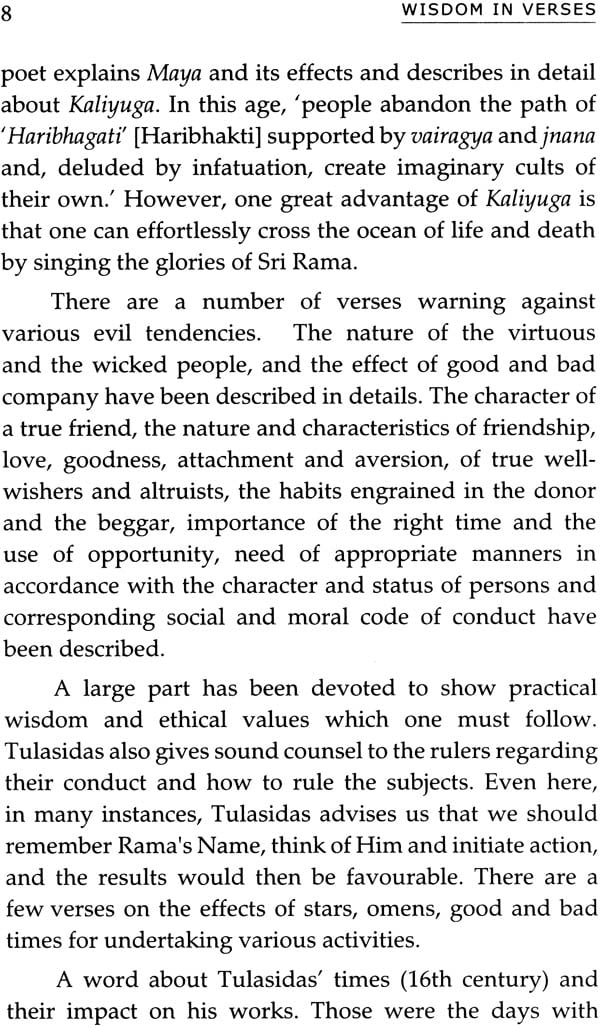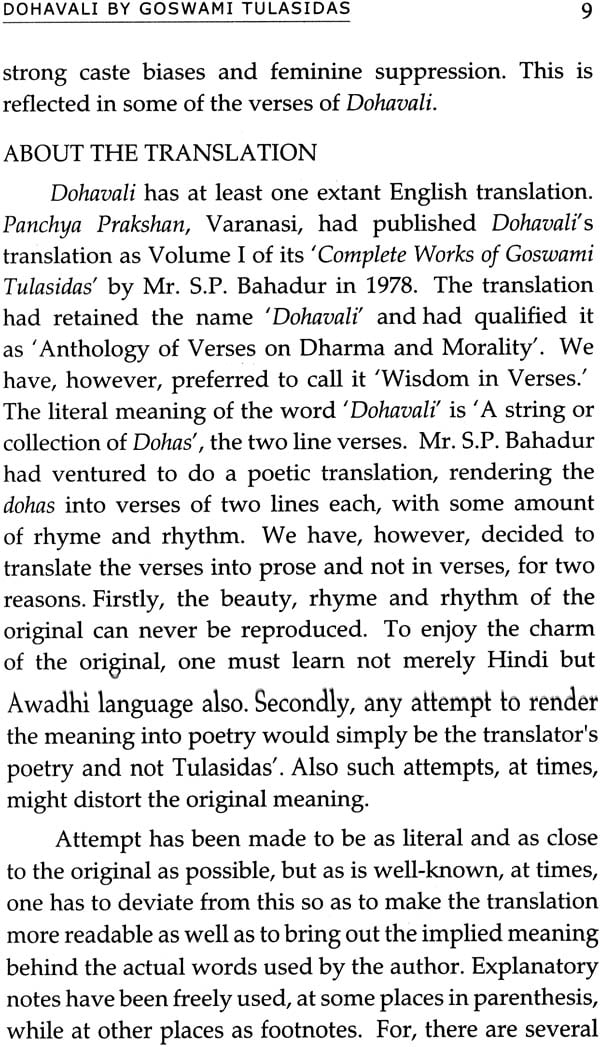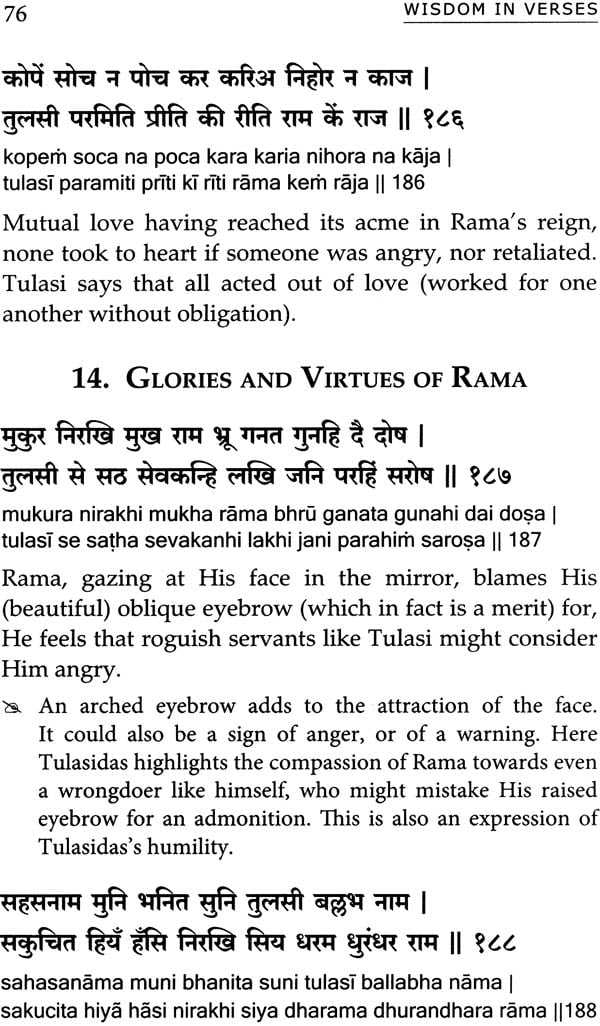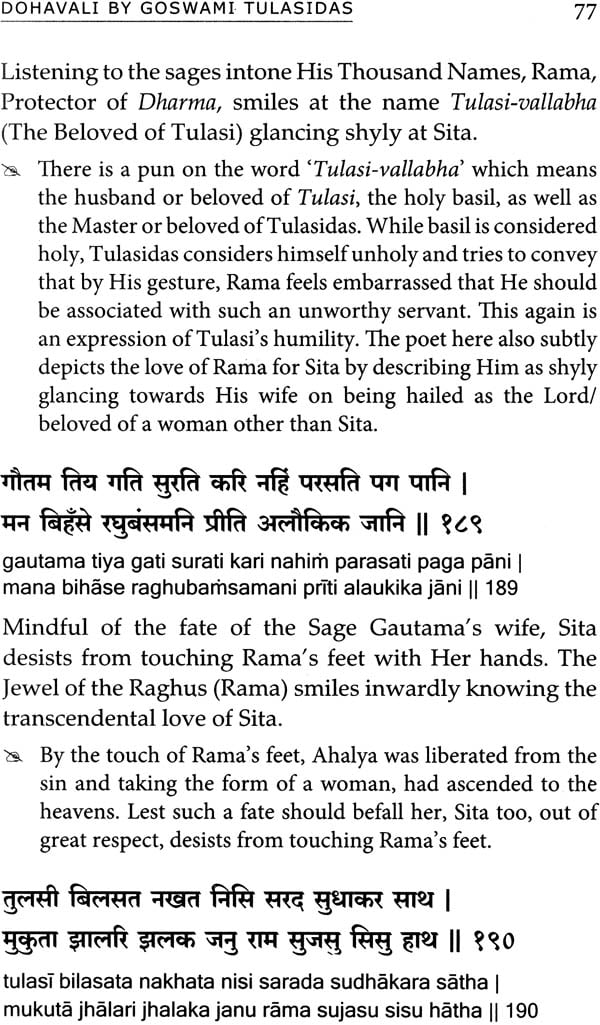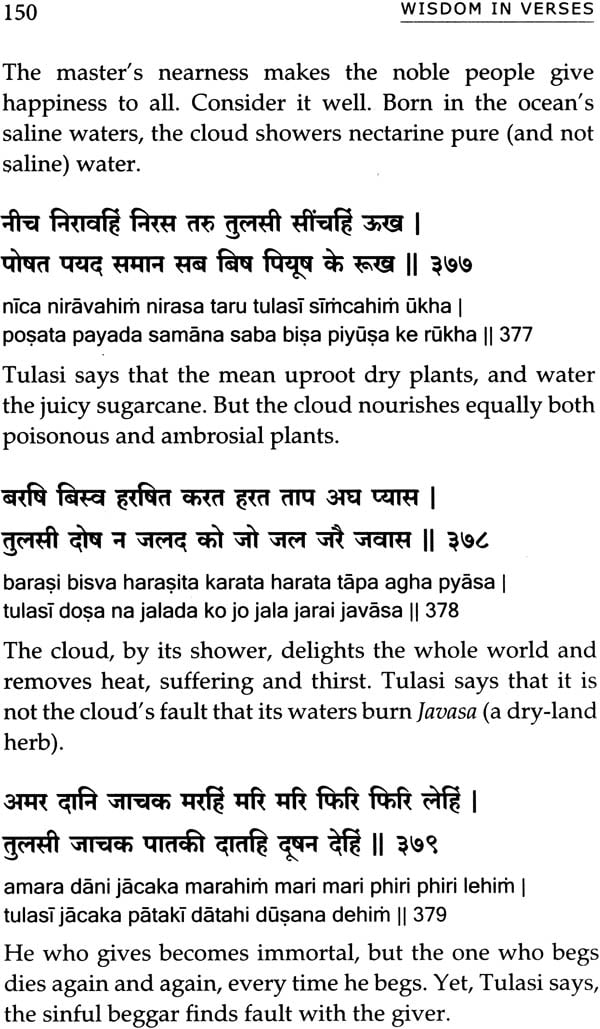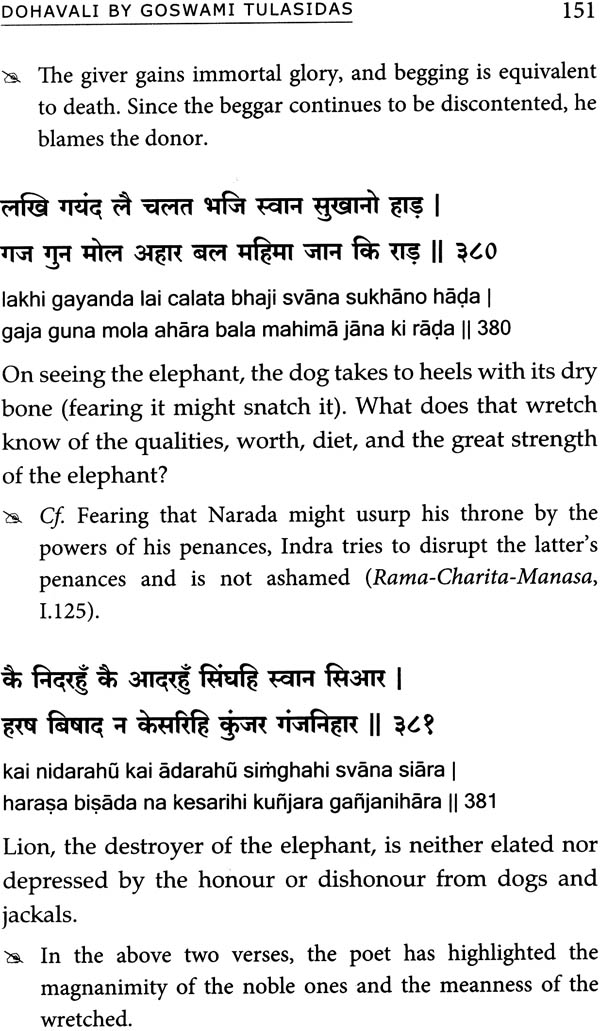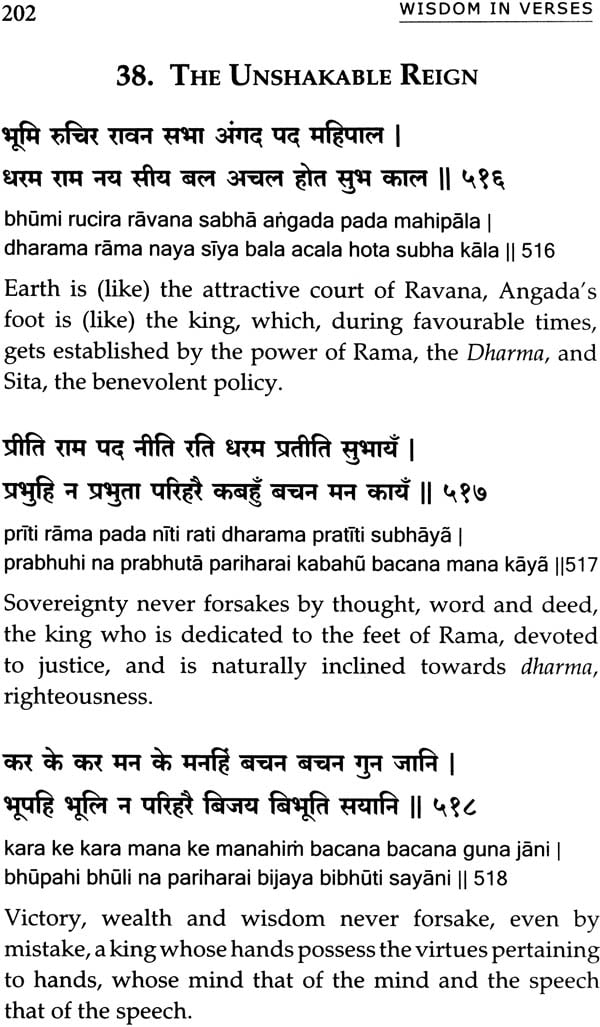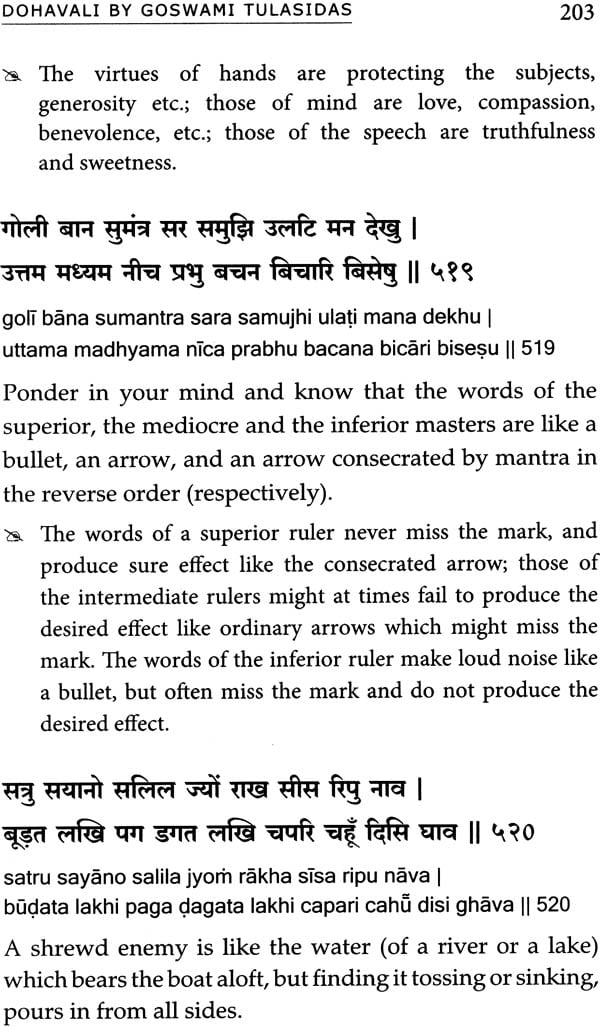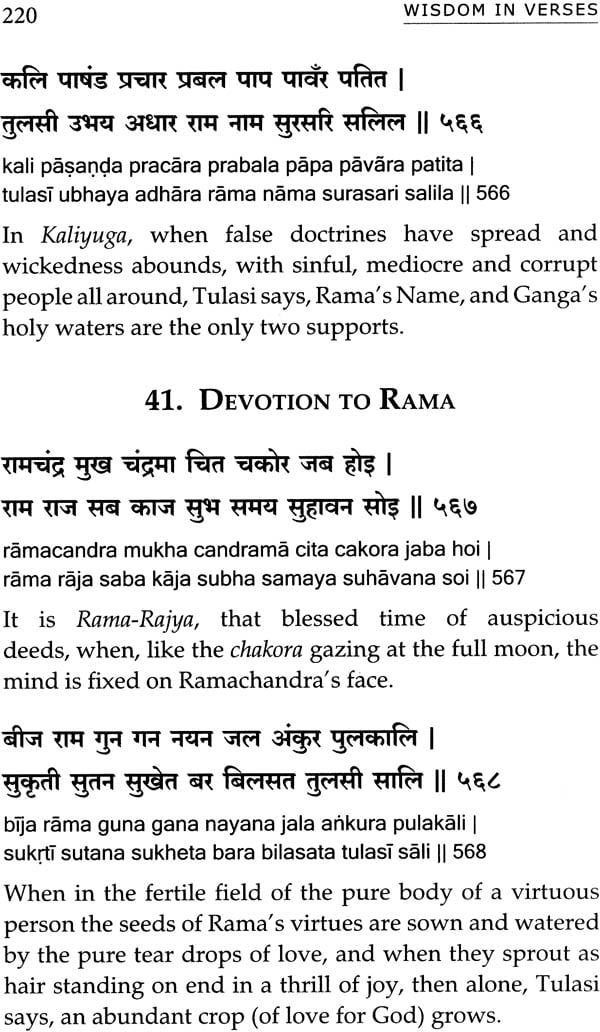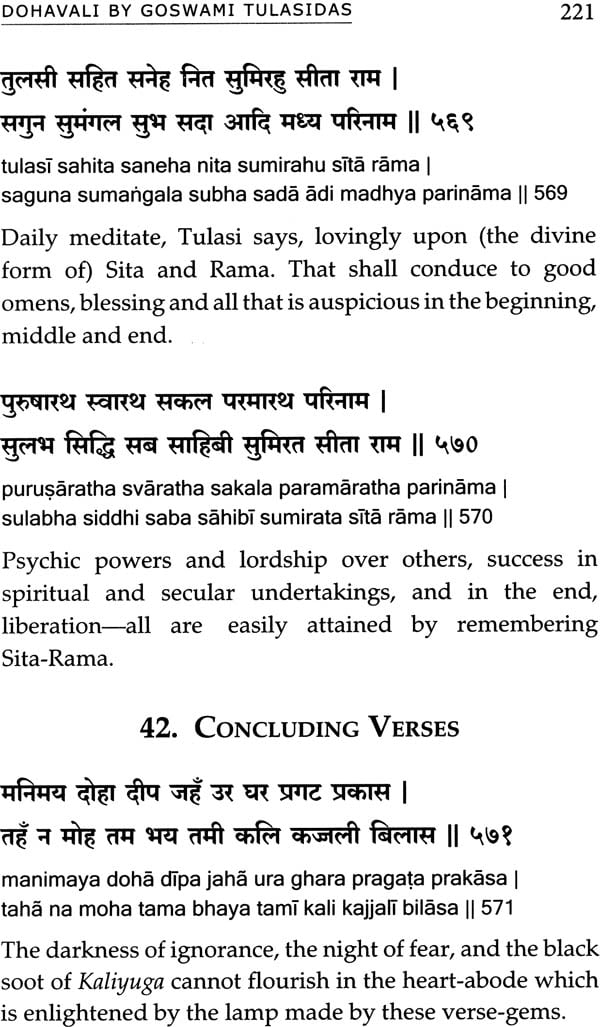
Wisdom in Verses (Dohavali)
Book Specification
| Item Code: | NAK768 |
| Author: | Swami Brahmeshananda |
| Publisher: | Sri Ramakrishna Math |
| Language: | Hindi Text With Transliteration and English Translation |
| Edition: | 2014 |
| ISBN: | 9788178836621 |
| Pages: | 232 |
| Cover: | Paperback |
| Other Details | 8.5 inch X 5.5 inch |
| Weight | 220 gm |
Book Description
Tulasidas was born in the village of Rajapur in the district Banda near Prayag (Allahabad) in Uttar Pradesh in Samvat 1554 (year of Indian Calendar) [1497 AD]. His father was Atmaram Dube and mother Hulasi Devi. It is said that he was a big baby, and did not cry at birth, but instead uttered 'Rama'. Tulasi became an orphan when he was just a child and was reared up by a maid named Chunia. This foster mother too passed away when he was five years old. It is believed that Goddess Parvati Herself, out of compassion, fed him daily in the garb of a Brahmin lady.
Soon Sri Naraharyananda (Narahari), a disciple of Sri Anantananda of Ramashaila, found the child Tulasi and took him under his protection. He named him Ramabola, invested him with the sacred thread and initiated him in the Rama Mantra. Ramabola now started studying under the tutorship of his guru at Ayodhya. He had a sharp intellect and a prodigious memory. Sri Narahari told the story of Rama to Ramabola. From Ayodhya, the guru and the disciple undertook a pilgrimage of several holy places and eventually arrived at Srikarakshetra (Soron). Later they shifted to Kashi (Varanasi) where Ramabola studied the scriptures from Shesha-Sanatana. He was renamed Tulasidas. Tulasidas finally settled in Kashi as a preacher of the Rama's story.
Tulasidas was married to a girl named Ratnavali. He was inordinately attached to his wife. Once she went to her father's home without informing Tulasidas. The latter could not bear the separation and virtually ran to meet her through heavy rain and flooded river. His wife was extremely annoyed and rebuked him saying, 'You would have attained liberation if you had even half the attachment you have for my body made of bones and flesh for Sri Rama.' This event proved the turning point in Tulasidas's life. He was cut to quick and immediately renounced the world and went first to Prayag and, according to some narratives, undertook a pilgrimage to Ayodhya, Ramesvaram, Dvarka, Badrinarayana, even as far as the Manasarvara (which might have inspired him to use this lake as metaphor for and name of the Rama- Charita-Manasa). Finally, he settled at the Asi Ghat of Kashi.
It is said that Goswamiji had an encounter with a Brahmaraksasa (a Brahmana's ghost) who advised him to seek Sri Hanuman's help for getting Sri Rama's vision. Sri Hanuman is supposed to attend the narration of the story of Rama wherever it is held. Accordingly, Tulasidas recognized him. Sri Hanuman predicted that he would have a vision of Sri Rama at Chitrakoota. At Chitrakoota, Tulasidas once saw Sri Rama and Lakshmana as two handsome youth on horses, but could not recognize them. Later, on the river bank, Sri Rama came in the form of a boy and asked Tulasidas to apply sandal paste to him. Sri Hanuman in the form of a parrot revealed Sri Rama's identity to him. Tulasidas was ecstatic at the divine vision of his beloved Lord who disappeared after putting the sandal paste mark on the forehead.
The next part of the story concerns the composition of the Rama-Charita-Manasa, the magnum opus of Tulasidas. Originally, Tulasidas started composing verses in Sanskrit, but by the command of Lord Shiva in a dream, he went to Ayodhya and wrote in the vernacular. It took him two years, seven months and twenty six days to complete the composition of the Rama-Charita-Manasa.
Tulasidas settled in Kashi and started narrating the Rama-Charita-Manasa, and soon become famous. The other scholars of Kashi became jealous and began propaganda against him and his composition on the ground that it was not in Sanskrit and therefore could not be accepted. An attempt was also made to steal and destroy the book. However, as the thief approached Tulasidas' cottage, he found two youth with bows and arrows guarding the cottage. This vision transformed the thief and he became a devotee. When Tulasidas learnt about the incident he felt sorry that Rama, his adored Lord, had to guard his cottage. He, out of remorse, distributed his belongings.
The scholars now requested Madhusudana Saraswati, the great contemporary scholar, to assess Tulasidas' work. Madusudana Saraswati was charmed by the Rama-Charita-Manasa and expressing his opinion said:
'In this forest of bliss (Kashi), Tulasidas is a moving holy basil plant whose poetry is like the flower which is adored by Rama, the Celestial Bee.'
Finally, it was decided to take the help of Lord Vishwanath Himself for deciding the worth of Tulasidas' composition. Accordingly, a copy of the Rama-Charita-Manasa was stacked with the Vedas and other scriptures over it in the temple before Lord Vishwanath. The temple was locked for the night. In the morning, Rama-Charita- Manasa was found above all other books!
It is said that one night Kaliyuga appeared before Tulasidas assuming a human form and started tormenting him. Tulasidas prayed to Sri Hanuman, who advised him to write verses of supplication. Accordingly, Tulasidas composed his second important work, Vinaya Patrika.
The legendary life of Tulasidas is full of miraculous occurrences. He lived a long life of 126 years and passed away in Samvat 1680 [1623 AD] at Asi Ghat, Kashi, chanting Rama's name.
Works of Tulasidas and Dohavali
J T F Jordens says, 'Tulasidas' incalculable influence on Hinduism in North India was threefold. He inspired an intense devotion to Rama that touched upon every aspect of life. Tulasidas inculcated a high sense of morality, and of kindness in human relationships. And he proved to be a great force in strengthening the structures of the Sanatana Dharma at a time when both Islam and the many iconoclastic sects were threatening it seriously. In this aspect, his stature is no smaller than that of the great Sankaracharya himself.' (Medieval Hindu Devotionalism, Chapter XVIII. p. 276-7; A Cultural History of India, Ed. By A. L. Basham. New Delhi, Oxford University Press, 12th impression, 2008).
| Publisher's Note | v | |
| Key to Transliteration and Pronunciation | vii | |
| Introduction | 1 | |
| 1 | Meditation | 11 |
| 2 | Glory of Rama's Name | 12 |
| 3 | Love for Rama | 26 |
| 4 | Evil Effects of Turning A way from Rama | 33 |
| 5 | Devotion for Rama and How to Get It | 38 |
| 6 | Rama's Grace | 47 |
| 7 | Rama, the Divine Child | 51 |
| 8 | Devotion to Rama | 54 |
| 9 | Glory of Rama's Servant | 59 |
| 10 | Means of Obtaining Love for Rama | 63 |
| 11 | Rama the Compassionate | 64 |
| 12 | Prayer | 72 |
| 13 | The Glory of Rama-Rajya | 74 |
| 14 | Glories and Virtues of Rama | 76 |
| 15 | Rama's Love | 82 |
| 16 | Rama's Household | 83 |
| 17 | Jatayu, the Fortunate | 90 |
| 18 | Hanuman | 92 |
| 19 | Glory of Kashi and Shiva | 95 |
| 20 | Wisdom Verses | 97 |
| 21 | Maya and the Ways of the World | 103 |
| 22 | Ode to Chataka | 111 |
| 23 | Other Examples of One-sided Love | 124 |
| 24 | On Friendship, Love and Goodness | 128 |
| 25 | Ways of the Wicked | 132 |
| 26 | The Wicked and the Virtuous | 135 |
| 27 | Good and Bad Company | 143 |
| 28 | The Wicked and Their Ways | 158 |
| 29 | Sin is the Root of Sorrow | 164 |
| 30 | Forgiveness, Love and Reconciliation | 169 |
| 31 | Do not Boast | 173 |
| 32 | Who is Worthy of Praise? | 174 |
| 33 | Importance of Right Time | 174 |
| 34 | Stars and Omens | 179 |
| 35 | About Vedas | 182 |
| 36 | Wise Counsel | 183 |
| 37 | Kingly Wisdom | 195 |
| 38 | The Unshakable Reign | 202 |
| 39 | Stray Verses of Wisdom | 207 |
| 40 | Kaliyuga | 212 |
| 41 | Devotion to Rama | 220 |
| 42 | Concluding Verses | 221 |
